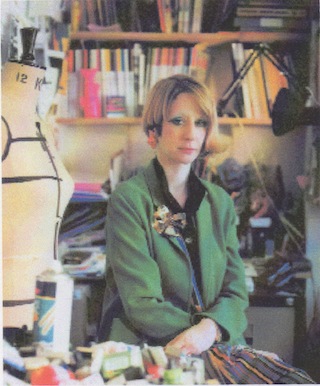People on the Verge
Julie Verhoeven

In the tradition of great fashion illustrators, it would not be implausible to add Julie Verhoeven's name to the list alongside Erte, Gruau and Beardsley. As the accolades for her current collection for Gibo flood in, Verhoeven credits her illustrations as a fundamental part of her design process.
After graduating in fashion from Kent's Medway College in 1987, Verhoeven began as John Galliano's first assistant. "At the beginning of each collection," she told SHOWstudio in 2000, "John would spend a couple of weeks in the library at the V&A and l'd go with him to carry the books and do some photocopying. That was fantastic; I loved research and that is why my work is so heavily research-based. John would start sketching frantically and I might get little bits to work on: drawings to re-draw which was crazy because his drawings were gorgeous anyway."
Her experience with Gallano laid the path to design consultation for Richard Tyler, Martine Sitbon, Jasper Conran, Byblos, Guy Laroche and Jean Colonna, creative direction on pop videos and record sleeves and lecture requests from various universities including London's ubiquitous and influential Central St. Martins. Then in 2001, Marc Jacobs commissioned Verhoeven for a limited edition set of must-have appliqué bags for Louis Vuitton featuring her characteristic artwork.
These illustrations, emblematic of her sweetly erotic, dreamy drawings featured languid, angular, sexy characters suggesting the influence of Francisco Clemente and Egon Schiele but with a sense of retro cheekiness. With these bags - and subsequent contributions to publications like Dazed and Confused, The Face and The Independent - the fashion world realized her skills could be focused beyond the page and onto the catwalk.
Surpassing any doubt that fashion illustration was art, Verhoeven submitted her work to group gallery exhibitions including an infamous collaboration in 2002 with New York electro sensations Fischerspooner That same year she published her first book. "Fat-Bottomed Girls", in which she presented 24 drawings dedicated to the pop songs she listened to when drawing, including Queen's eponymous title track.
In 2002, Verhoeven's varied past collided when she was sought out as designer for the Italian label Gibo. Known primarily as a manufacturer for Hussein Chalayan, Alexander McQueen, Helmut Lang and Viktor & Rolf, Gibo wanted to reestablish itself as an individualistic yet wearable design label. Verhoeven was given free reign to infuse the collections with her own brand of wit and personality.
At London Fashion Week in February, Verhoeven's Autumn/Winter 2004 collection for Gibo was emblematic of her background. Influenced as much by Bowie's White Clown and school discos as haute couture, the outfits were a liberated mix of her signature eighties abandon with swiss tailoring - loose and effortless but with a keen attention to detail. The collection showed an approachable eccentricity and an understanding of the body, silhouette, pose and the way clothes hang; an aptitude undoubtedly achieved through the repetitive nature of drawing for illustration and further evidence of how graphics play an essential role in the development of her fashion from concept to finished garment. Through this process she joins a thoroughly modern fashion fraternity of designer as collagist mixing pop, fashion and high art.
Recently Gibo opened its first store for Verhoeven in London's Conduit Street. Unsurprisingly, she was involved in every aspect of the shop's visual presentation including the addition of her own drawings to the interior. Gibo's obvious faith in her creativity is another giant step in elevating Julie Verhoeven's name into the global fashion consciousness.
Jon Scott Blanthorn

